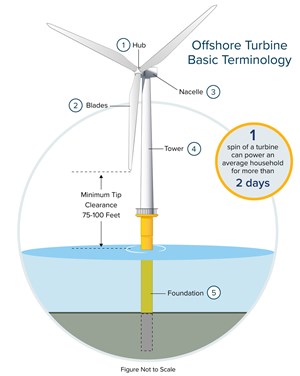First oil
As those of you reading this column regularly will attest to, this editor has pointed out repeatedly in recent months the failings of UK political leaders on energy policy. Their collective effort has been just plain awful. Now comes confirmation of this from Britain’s largest industry trade association, Offshore Energies UK (OEUK).
The UK’s failure to build enough low-carbon sources of electricity, plus proposals to halt North Sea oil and gas exploration, will put the nation at ever-greater risk of a new energy crisis, says the group’s chief executive, David Whitehouse, Fig. 1. He believes the situation “risks double jeopardy for UK energy security.”
Whitehouse’s comments follow publication of a report by the non-departmental public body, Climate Change Committee (CCC). The document is CCC’s annual “Progress in Reducing Emissions Report” for 2023. In this report, CCC members call for a moratorium on airport expansion, a nine-fold increase in the rate at which heat pumps are installed in homes, and a doubling of tree planting.
By the same token, and crucially, the report also warns that the UK is failing to build enough sources of low-carbon electricity. It points out that the UK would need to quadruple low-carbon power generation in just the next seven years to meet its own emission reduction targets. This is because 42% of UK electricity currently comes from gas-fired power stations, and because surging sales of electric vehicles are pushing up demand. The report also accuses the UK government of “backtracking on fossil fuel commitments” because of its support for continued UK oil and gas production and criticizes it for “losing its clear global leadership position on climate action.”
Whitehouse said that OEUK supported CCC’s net zero targets, but the report’s proposals for achieving it would put the UK at increased risk of a new energy crisis. “The CCC report’s findings are paradoxical,” complained Whitehouse. “On the one hand, it warns that the UK is being far too slow at building the infrastructure vital for generating low-carbon electricity. That clearly means we will need other sources of energy to tide us over while we build those new windfarms, solar farms and nuclear power stations. But the same report also supports a ban on exploring UK waters for new sources of gas and oil, so depriving the UK of that resource, too.”
OEUK’s chief executive then went further. “There are 283 oil and gas fields in UK waters, but many are ageing, and 180 will be shut down by 2030,” he noted. “If we don’t replace them, the UK will become up to 80% reliant on imports. We need new fields, just to maintain production and so minimize imports. Put together, these policies mean the UK risks creating its own home-grown energy crisis—and that will hit home around 2028. That’s likely to be when the next government is seeking re-election.”
Offshore wind tower shortage looming in Europe. While the energy policy debate rages on in the UK, a new crisis is brewing for Europe as a whole. Recent modeling from Rystad Energy indicates a shortage of offshore wind towers (Fig. 2) will result from the continent’s demand for these structures exceeding manufacturing capacity by 2028. It appears that time is running out for Europe to address the issue and ramp up production capabilities.

Right now, Rystad’s outlook shows that wind tower manufacturing capacity will keep pace with, and exceed, demand before 2028. However, that year is the turning point, and in 2029, “demand will surpass manufacturing capacity by a significant margin.” The firm says that steel demand for offshore wind towers will total more than 1.7 million tonnes in 2029, but manufacturing capacity will be a maximum of around 1.3 million tonnes. This means that supply can only meet about 70% of demand.
Rystad says that if Europe is to reverse the trend, manufacturers need to initiate expansion in the next two years, as it takes between two and three years to build new facilities. These forecasts assume no major steel shortage. “Turbine sizes keep growing, as the importance of offshore wind to the global power grid accelerates, and tower demand is projected to surge accordingly,” said Alexander Fløtre, vice president at Rystad Energy.
Natural gas critical to agricultural sector. With too little rain falling in many parts of the U.S. this year, and too much rain occurring in other areas of the country, concern is mounting about the productivity of various crops. Everything from corn to soybeans, cotton and wheat is under scrutiny, as analysts try to gauge what farmers will ultimately produce during 2023.
So, it seems like a good time to re-visit a fairly recent study from the American Gas Association (AGA), which says that natural gas is critical to the U.S. agricultural sector. Released in late March, the study is entitled “Advancing America’s Agriculture: The Value of Natural Gas to U.S. Agriculture and Agrochemicals.” It rightfully notes that “the American farmer relies on domestic natural gas for the fertilizer in their fields (Fig. 3), the fuel to run their equipment, and energy to process, store and transport our nation’s food supply to feed 330 million Americans, in addition to countless individuals overseas, who depend on U.S. agricultural exports.”

Findings of the report include:
- U.S. agriculture is one of the largest consumers of natural gas, consuming roughly 1.7 Tcf, equivalent to almost 15% of all U.S. commercial and industrial demand.
- Fertilizer and other agrochemical production is the most significant consumer of natural gas in the agricultural supply chain.
- Natural gas is required to produce nitrogen, a main fertilizer component, which enables increased crop yields.
- Between 70% and 80% of the energy used to produce critical fertilizers comes from natural gas.
- The U.S. agricultural sector supports 17.2 million jobs and approximately $1.75 trillion in U.S. GDP, roughly equivalent to the GDP of Texas, the second largest state in the country.
Obviously, low-cost natural gas is essential to U.S. agriculture, and there should not be efforts to reduce its supply. It goes without saying that the U.S. cannot afford to drive up the cost of food for Americans in a time of inflation, and when weather is exacerbating the situation.
Better long-range weather forecasting for energy. Speaking of weather, EIC Rose Rock, an early-stage venture capital fund focused on energy technologies, has made a direct investment in Salient Predictions, a Boston-based weather analytics company. Developed by Massachusetts Institute of Technology (MIT) and Woods Hole Oceanographic Institution scientists, Salient’s forecasts and analytics use superior data and advanced methodologies to deliver Subseasonal to Seasonal (S2S) weather forecasts, two to 52 weeks in advance.
Obviously, weather forecasting is important, so that producing companies can better forecast how much energy they will be able to supply for upcoming weeks to electrical generators, like those that are part of ERCOT in Texas. In addition, weather forecasting helps operators, NOCs, oilfield service companies and drilling contractors to know what to expect in the field, so that they can plan accordingly.
EIC Rose Rock and its sister organization, energy tech incubator Rose Rock Bridge, have joined other investors to not only provide funds but also to expand Salient’s operations in Tulsa, Okla. The initial investment totals $3 million.
Raytheon forced to bring back retirees for Stinger production. For those of you wondering how long the war in Ukraine might go on—as it has implications for natural gas flows and consumption—the state of FIM-92 Stinger missile usage and production may offer a clue. In late June, Raytheon told military/defense website Defense One that it has been forced to bring engineers in their 70s out of retirement and back to work, to re-start production of Stinger missiles, so they can be sent to Ukraine. The rehired engineers will help to train younger staff and restart production of the missiles, which have not been produced for two decades.
Additional production of the Stinger is required, as the U.S. already has sent nearly 2,000 of the heat-seeking missiles to Ukraine for its battles with Russia. All the missiles sent came from U.S. stockpiles, and the Biden administration said in late June that it will send even more of them to Ukraine. The Stinger is a surface-to-air missile originating from the U.S., which is designed for use by ground troops via shoulder launching. Yet, it also can be fired from various vehicles or helicopters. Since 1981, it has been used by the U.S. and 29 other countries.
“Stinger’s been out of production for 20 years, and all of a sudden, in the first 48 hours [of the war], it’s the star of the show and everybody wants more,” said Wes Kremer, president of RTX’s Raytheon division, during an interview at the Paris Air Show, according to Defense One. In further comments, he said, “We’re pulling test equipment out of warehouses and blowing the spider webs off of them.” Indeed, blueprints for the weapon are well over 40 years old, dating back to the administration of former President Jimmy Carter.
When the U.S. Army placed an order for 1,700 Stingers in May 2022, the Pentagon said the missiles wouldn’t be delivered for four years, until 2026. As stated by Kremer, it will take 30 months (2.5 years) to set up the Stinger production line and train employees for it. So, taking all of this into account, should we conclude that the Pentagon believes that the war in Ukraine will last until at least mid-2026? Imagine how the natural gas trade in Europe will evolve, accordingly.
Government expressed in scientific elements. Finally, we share with you a piece of governmental spoofing that one of our editorial advisors recently rediscovered on the Internet. It appears to be about 20 years old, and author unknown, but in light of recent governmental foolishness in the U.S. and other countries, it is worth revisiting:
University researchers have discovered the densest element yet known to science
The new element, Governmentium (symbol=Gv), has one neutron, 25 assistant neutrons, 88 deputy neutrons and 198 assistant deputy neutrons, giving it an atomic mass of 312.
These 312 particles are held together by forces called morons, which are surrounded by vast quantities of lepton-like particles called pillocks.
Since Governmentium has no electrons, it is inert. However, it can be detected because it impedes every reaction with which it comes into contact.
A tiny amount of Governmentium can cause a reaction that would normally take less than a second, to take from 4 days to 4 years to complete.
Governmentium has a normal half-life of 2 to 6 years.
Governmentium does not decay, but instead undergoes a reorganization in which a portion of the assistant neutrons and deputy neutrons exchange places. In fact, Governmentium's mass will actually increase over time, since each reorganization will cause more morons to become neutrons, forming isodopes.
This characteristic of moron promotion leads some scientists to believe that Governmentium is formed whenever morons reach a critical concentration. This hypothetical quantity is referred to as a critical morass.
When catalyzed with money, Governmentium becomes Administratium (symbol=Ad), an element that radiates just as much energy as Governmentium, since it has half as many pillocks but twice as many morons.
Sound familiar?
IN THIS ISSUE
Special focus: Permian Basin Technology. In this month’s lead theme, authors from ProFrac Services and Life Cycle Power discuss how mobile electric microgrids address the power demands of high-intensity fracing. They say that remote e-frac technology enables operators to wield high and variable power loads to slash costs and reduce emissions. Meanwhile, several authors from Halliburton and Crownquest describe how utilizing electronic data captured at the bit improves PDC design and drilling performance. A sensor at a PDC bit measures downhole dysfunction and is used in combination with an automated dull grading system to calculate bit damage. The high-frequency data enable engineers to determine the bit design changes required to improve drilling efficiency.
Digital twin technology/Unconventional resources: Optimizing operation performance with digital ecosystem. An author from Vertechs Group says that integrating data analytics, smart equipment and digital twin technology optimizes drilling operations by analyzing historical data, predicting drilling issues and providing real-time monitoring. Combined, these technologies minimize mud loss and reduce NPT to lower drilling costs. In a case study, an analysis was performed by an operator based in China, which has drilled numerous wells in the southwestern shale region. The operator successfully implemented cost-effective solutions to maintain a normal drilling process and avert mud loss on the fly.
The C-suite Series: Exclusive interview with Chevron Executive V.P. Nigel Hearne. In the first installment of our new interview series, Mr. Hearne expresses optimism about his firm’s growth in a future of low-carbon operations. In this wide-ranging discussion, he talks about Chevron’s ongoing operations, future projects, embrace of lower-carbon technologies, and overall operating philosophy. Now nine months into his current position, Mr. Hearne says that what stands out to him over a 34-year career is a sense of gratitude for the remarkable individuals that he has had the opportunity to work with. Throughout the years, he has witnessed first-hand the power of human ingenuity to solve complex challenges.

- Dallas Fed: Outlook improves, even as activity little changed; break-even prices increase (April 2024)
- The last barrel (February 2024)
- Oil and gas in the Capitals (February 2024)
- What's new in production (February 2024)
- First oil (February 2024)
- E&P outside the U.S. maintains a disciplined pace (February 2024)
- Applying ultra-deep LWD resistivity technology successfully in a SAGD operation (May 2019)
- Adoption of wireless intelligent completions advances (May 2019)
- Majors double down as takeaway crunch eases (April 2019)
- What’s new in well logging and formation evaluation (April 2019)
- Qualification of a 20,000-psi subsea BOP: A collaborative approach (February 2019)
- ConocoPhillips’ Greg Leveille sees rapid trajectory of technical advancement continuing (February 2019)




